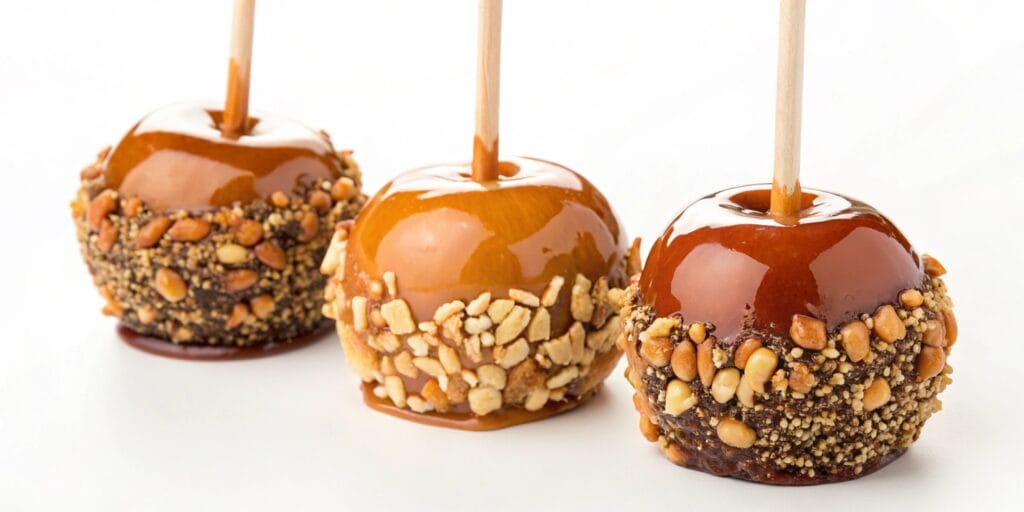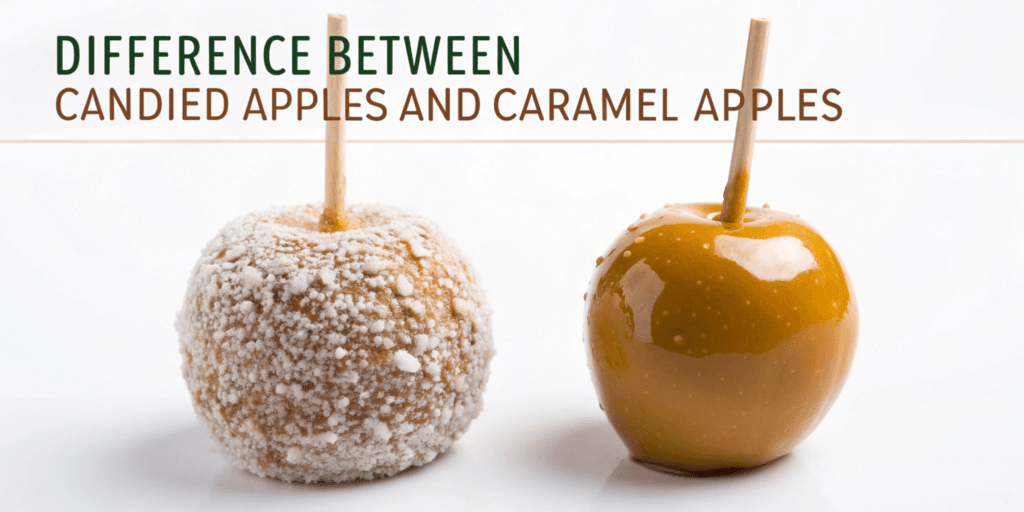What is the Difference Between Candied Apples and Caramel Apples?
When it comes to fall treats, apples are a versatile favorite. Two iconic apple-based desserts, candied apples and caramel apples, dominate the season. While both start with a fresh, crisp apple, their coatings, textures, and flavors set them apart. But what is the difference between candied apples and caramel apples? This comprehensive guide will delve into their ingredients, preparation methods, history, and cultural significance while offering insights into which one might be the healthier choice.
If you’re curious about caramel apple varieties or looking to buy them locally, explore our guide on Caramel Apples Near Me. For tips on proper storage, don’t miss our article on Do I Need to Refrigerate Caramel Apples?.
Overview of Candied and Caramel Apples
What is the Difference Between Candied Apples and Caramel Apples?
What Are Candied Apples?
Candied apples are known for their vibrant red candy shell, created by boiling sugar, corn syrup, and water to a hard-crack stage. This mixture, often flavored with cinnamon or cherry and colored red, creates a hard, glossy coating that encases the apple. Candied apples are a popular sight at fairs and Halloween events, offering a bold, sweet crunch with every bite.
What Are Caramel Apples?
Caramel apples, in contrast, are coated with a soft, creamy caramel layer made by melting caramel with cream or butter. Their pliable texture allows for a variety of toppings, such as crushed nuts, sprinkles, or chocolate drizzle. Caramel apples are celebrated for their rich, buttery flavor and versatility.
To learn more about the nutritional comparison of caramel apples and healthier alternatives, check out our post on Is Caramel Apple a Healthy Snack?.
Ingredients and Preparation
Candied Apples
Candied apples are crafted with:
- Sugar and corn syrup: These provide the candy’s base.
- Water: Prevents the sugar from burning during boiling.
- Food coloring: Creates the classic red hue.
- Optional flavors: Commonly cinnamon or cherry.
Preparation Steps:
- Boil the sugar mixture to the hard-crack stage (approximately 300°F).
- Dip the apples into the syrup, coating them evenly.
- Allow the coating to harden at room temperature.
Caramel Apples
Caramel apples rely on:
- Caramel: Made from sugar, cream, and butter.
- Apples: Often tart varieties, like Granny Smith, to balance the sweetness.
- Toppings: Crushed nuts, chocolate drizzle, or coconut flakes.
Preparation Steps:
- Melt caramel with cream and butter for smooth consistency.
- Dip apples, ensuring an even caramel coating.
- Add toppings before the caramel sets.
Looking for DIY inspiration? Check out our comprehensive Costco Caramel Apples Guide for ready-made and homemade options.
Texture and Taste Differences
What is the Difference Between Candied Apples and Caramel Apples?
Candied Apples
- Texture: Hard, crunchy shell that provides a satisfying crack with each bite.
- Taste: Intensely sweet with a slight tang, especially if flavored with cinnamon.
Caramel Apples
- Texture: Soft, creamy, and chewy.
- Taste: Rich, buttery sweetness with added depth from toppings like nuts or chocolate.

Historical Origins
What is the Difference Between Candied Apples and Caramel Apples?
The History of Candied Apples
Candied apples were invented in the early 1900s by a candy maker experimenting with red cinnamon candy syrup. The shiny red coating quickly made them a popular fall treat, synonymous with Halloween and fairgrounds.
The History of Caramel Apples
Caramel apples came later, originating in the mid-20th century as a way to use up surplus caramel candies. Their soft texture and customizable toppings made them a favorite at fairs and family gatherings.
For a deeper dive into their histories, visit Gold Medal Products Co..
Popularity and Cultural Significance
When and Where Are They Enjoyed?
Both candied and caramel apples are fall staples, commonly enjoyed during:
- Halloween: Their festive appearance makes them a hit with children and adults alike.
- Fairs and Carnivals: Easy to make and carry, they’re a fairground classic.
- Fall Festivals: Their association with apples and the harvest season makes them a natural fit.
Regional and Global Variations
- Candied Apples: Variations like jelly apples (a softer candy shell) are popular in some regions.
- Caramel Apples: In some areas, caramel apples are enhanced with gourmet toppings like sea salt, white chocolate drizzle, or even edible gold flakes.
Which One Is Healthier?
When considering which treat is healthier, it’s essential to look at their ingredients and preparation.
Nutritional Comparison
- Candied Apples: Lower in fat but high in sugar, offering little nutritional value beyond the apple.
- Caramel Apples: Higher in calories due to the butter and cream in caramel but provide more flexibility for healthier toppings like nuts or seeds.
Moderation and Healthier Alternatives
For a healthier take:
- Candied Apples: Use natural food coloring and reduce sugar content.
- Caramel Apples: Opt for low-sugar or dairy-free caramel recipes.
For more wholesome fall treats, consider our recipe for Pumpkin Banana Loaf, a perfect companion to these apple delights.

Frequently Asked Questions (FAQ) about What is the Difference Between Candied Apples and Caramel Apples?
1. What is the main difference between candied apples and caramel apples?
Candied apples have a hard candy shell, while caramel apples are coated with a soft, chewy caramel layer.
2. Are candied apples harder to make than caramel apples?
Yes, candied apples require precision to reach the hard-crack stage of boiling sugar, while caramel apples are more forgiving during preparation.
3. Which is better for children: candied apples or caramel apples?
Caramel apples are generally preferred due to their softer texture, making them easier to eat.
4. Can you use the same apple varieties for both treats?
Yes, tart apples like Granny Smith are ideal for both, as their flavor balances the sweetness of the coatings.
5. Are there sugar-free versions of these treats?
Yes, sugar-free caramel recipes and reduced-sugar candy coatings are available for those seeking healthier options.
Conclusion to What is the Difference Between Candied Apples and Caramel Apples?
While candied apples and caramel apples may share a similar base, their differences in preparation, texture, and flavor make them unique treats. Candied apples provide a hard, crunchy shell with bold flavors, while caramel apples offer a soft, creamy coating that pairs well with a variety of toppings. Both have their place in fall festivities, and the choice often comes down to personal preference.
Whether you enjoy the nostalgic crack of a candied apple or the indulgent chew of a caramel apple, both treats are delightful ways to celebrate the season. For more ideas on where to find them or how to make your own, check out Caramel Apples Near Me or learn about proper storage in Do I Need to Refrigerate Caramel Apples?.


3 thoughts on “What is the Difference Between Candied Apples and Caramel Apples?”